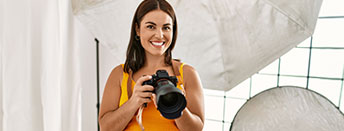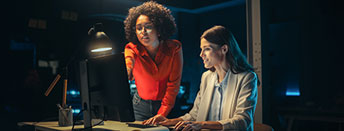At a Glance

$525
Cost per Credit
120
Credit Hours
100%
Online
2-4 years
Program LengthBachelor’s in Art & Design (BA or BFA)
Program Overview
At a Glance

$525
Cost per Credit
120
Credit Hours
100%
Online
2-4 years
Program LengthWhy Study Art & Design?
You thrive on creative expression. Build on this passion with a BA or BFA online art degree from Lindenwood University. Cover the essentials of your fine arts and design specialty in one of three emphasis areas, including Digital Art, Graphic Design, and Photography. Pursuing your design and fine arts degree online can give you the freedom to continue advancing in your creative practice while you learn.
Course Spotlight
Our online fine arts degree program lets you follow a BA or BFA path, cultivating a diversified background across artistic technique, craftsmanship, artistic innovation, project development, and problem solving. The online art degree culminates in a portfolio review that gives you the opportunity to showcase your artistry and offers a way to highlight this creativity to potential employers. Courses in this program includes:
- Introduction to Art & Design
- Adobe Certifications
- Portfolio Review
- Concentration-specific courses
BA vs. BFA Degree
The online Bachelor of Arts (BA) degree program is ideal for students who wish to double major or diversify their skills with additional minors and whose educational goal is to major in an art and design program that incorporates a more substantive study in the liberal arts, while the Bachelor of Fine Arts (BFA) online program provides the student the opportunity to learn the basics of art history and theory, while also allowing them to focus their studies on an emphasis area such as photography or graphic design. Both art degree online programs focus on creativity, problem solving, project development, teamwork, and mastery of technique and craftsmanship, while providing the interdisciplinary perspective necessary to succeed in today’s art and design fields.
Career Outlook
According to the Bureau of Labor Statistics (BLS), graphic designers can earn an average salary of $58,910 annually. Careers in this field are anticipated to add 8,900 new jobs between 2022-32. Other career paths in this field include Photographer, Studio Artist, Digital Artist, Exhibit Designer, Industrial Designer, and Art Educator.
Essential Skills & Insights
Coursework in this art degree online program covers the following:
- Interdisciplinary Learning. Examine approaches and concepts within other creative fields and practices, beyond your concentration area.
- Project Management. Learn to navigate the creative project lifecycle—from ideation to production.
- Problem Solving. Develop critical thinking skills that help you overcome challenges and create solutions within your artistic practice.
- Technological Literacy. Master the latest technologies within a number of areas of art and design fields and practices.
Tuition Details
The cost per credit hour for this online fine arts degree program is $495. Besides being ranked No. 17 on Niche.com’s list of Best Value Colleges in Missouri, we build in unique benefits such as our 20 percent discount per credit hour for returning alumni pursuing their master’s degree.
Admissions Requirements
For admission to your program, you will need to complete your online application and submit the following documents:
- Online application
- Official transcripts
All colleges and universities previously attended. If you have fewer than 24 college credits, you will need to submit your official high school transcript.
If cumulative college GPA is below a 2.0, the following will also be required:
- Résumé
- Letter of intent/personal statement
(1–2 page document indicating your interest in the program and Lindenwood)
TRANSFER CREDITS
Lindenwood offers a generous transfer policy of up to nine credits toward your degree completion to further offset tuition costs. This means you can complete your degree in as few as 30 credit hours at Lindenwood—saving you time and money on your education!
Plus, you can personalize your transfer experience through Lindenwood’s Transfer Guides. These guides are part of our articulation partnerships with area community college to help you get the most value from your transfer credit.
Learn MoreCurriculum Overview
The online BFA or BA in Art and Design program at Lindenwood University offers a comprehensive curriculum to foster creativity, technical skills, and critical thinking. In these courses, you will explore a wide range of artistic disciplines and techniques, including Digital Art, Graphic Design, Photography, and Web and User Experience, to prepare for diverse careers in the art and design industry.
Core Coursework – 24 Credit Hours
| Code | Title | Credits |
|---|---|---|
| AAD 10000 | Introduction to Art and Design | 3 |
| AAD 10050 | Web Design I | 3 |
| AAD 10600 | Design Foundations | 3 |
| AAD 13000 | Drawing I | 3 |
| AAD 13600 | 3D Design | 3 |
| AAD 20300 | Adobe Certification in Photoshop | 3 |
| AAD 20400 | Adobe Certification in Illustrator | 3 |
| AAD 35000 | Portfolio Review | 3 |
Major Coursework – 3 Credit Hours
| Code | Title | Credits |
|---|---|---|
| AAD 14000 | Visual Storytelling | 3 |
| CINE 11000 | Video Production | 3 |
Elective Coursework – 12 Credit Hours
| Code | Title | Credits |
|---|---|---|
| AAD 10100 | Emerging Technologies | 3 |
| AAD 11000 | Programming Logic | 3 |
| AAD 11600 | Drag and Drop Web Design | 3 |
| AAD 18101 | Digital Photography I | 3 |
| AAD 20000 | Painting I | 3 |
| AAD 21500 | Printmaking I | 3 |
| AAD 22100 | Sculpture I | 3 |
| AAD 22600 | Digital Art I | 3 |
| AAD 23400 | Fibers I | 3 |
| AAD 24100 | Ceramics I | 3 |
Practical Application Coursework – 6 Credit Hours
| Code | Title | Credits |
|---|---|---|
| AAD 44001 | Art and Design Firm | 3 |
| CAH 44444 | Internship | 1-6 |
Capstone Coursework – 3 Credit Hours
| Code | Title | Credits |
|---|---|---|
| AAD 41000 | Art and Design Capstone | 3 |
Art & Design Concentrations
Digital Art
The BFA in Art and Design with an emphasis in Digital Art provides the format and tools that allow traditional fine arts students to work in digital media. With a firm foundation in the theories and techniques of studio art, digital art majors will be provided the software skills necessary to thrive in the digital art and design industries.
Graphic Design
The BFA in Art and Design with an emphasis in Graphic Design covers several areas in design: print and publication, advertising, typography and illustration, web design, user experience, and motion design.
Photography
The Bachelor of Fine Arts in Art and Design with an emphasis in Photography provides students with a strong foundational principle of design focusing on creativity, problem-solving, project development and teamwork, and mastery of technique and craftsmanship. Students can apply these skills in videography, web design, and more. The online art degree is ideal for students who wish to delve deeply into the field and prepare a professional portfolio to enter a career directly after graduation.
Accreditation and Awards
Most Affordable Online College for Web and User Experience Design Degree
Most Affordable Online Graphic Design Degree
Career Opportunities

Graphic Designer
Create eye-catching designs for print and digital media, websites, product packaging, and more.

Photographer
Pursue careers in advertising, film production, or start your dream photography business capturing the magic of weddings, graduations, and other life events.

Art Director
Oversee the visual aspects of traditional and digital advertising, film and video production, and other creatives in a variety of industries.
Frequently Asked Questions
What is a BFA?
A BFA degree blends art theory with the practical aspects of artistry, including production and exhibition. Typically, a BFA curriculum consists mostly of study within areas across the fine arts, with liberal arts coursework rounding out these studies.
What can you do with an art degree?
Whether you aspire to produce or support fine arts, you can pursue a number of artistic career paths with your online fine arts degree — from graphic design to art gallery management and much more.
Are there scholarships for the online bachelor’s in art & design degree?
Yes, there are scholarships available for those pursuing a fine arts degree, and Lindenwood can help you explore these opportunities. Specifically in the area of fine arts, Lindenwood offers Fine Arts and Performing Grants.
Can you get a fine arts degree online?
Yes, in fact, you can earn your fine arts degree fully online at Lindenwood. With our generous transfer policy, you can transfer as many as 90 credits, potentially achieving your degree in as little as a year.
Is a fine arts degree worth it?
es, if your area of professional interest lies in an area within the arts, such as the following:
- Art education
- Creative writing
- Dance
- Dance education
- Design
- Film
- Music education
- Performing arts administration
- Studio art
- Theater
A BFA can give you the academic credential you need to launch or advance your artistic practice as a career.
What is studio art?
Studio art is the practice of creating visual art through a number of artistic media, including painting, drawing, ceramics, sculpture photography, printmaking, glass, fiber, or design. Studio art can also refer to visual art that is created in a studio setting.
Related Programs

Bachelor’s in Art History & Visual Culture
Develop a deeper understanding of artistic expression and visual design and production from a historical perspective.
learn more
Bachelor’s in Pre-Art Therapy
Channel your creative skills into therapeutic practice at social service agencies, nursing homes, schools, and more.
learn more
Bachelor’s in Game Design
Learn the skills to work in all phases of game development, from concept to prototype.
learn moreWe are committed to helping you succeed.
Throughout each step of your online degree program, you will receive support. From enrollment and tuition planning to staying on the right track, your support team is there to ensure your success.
Request Info